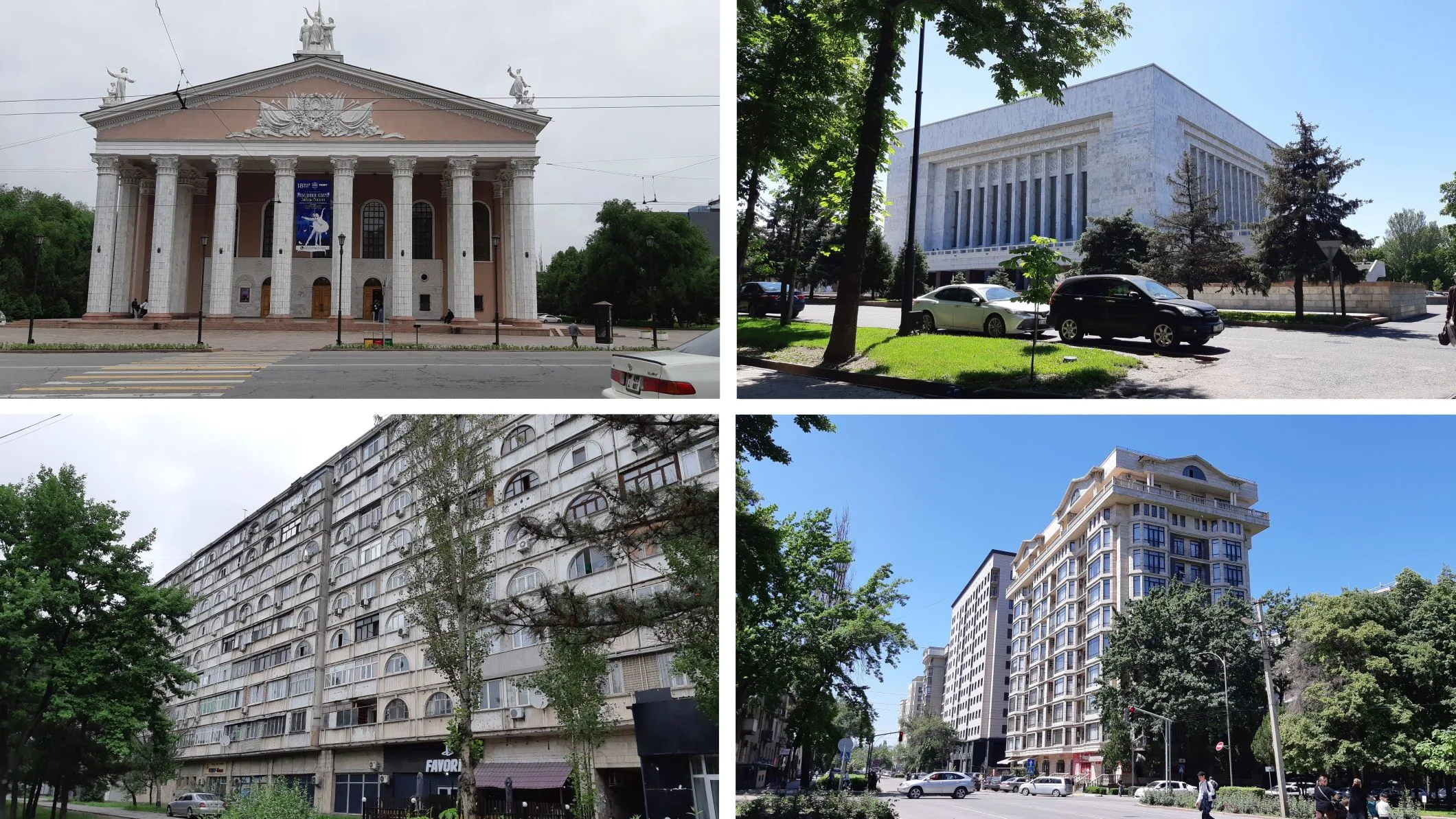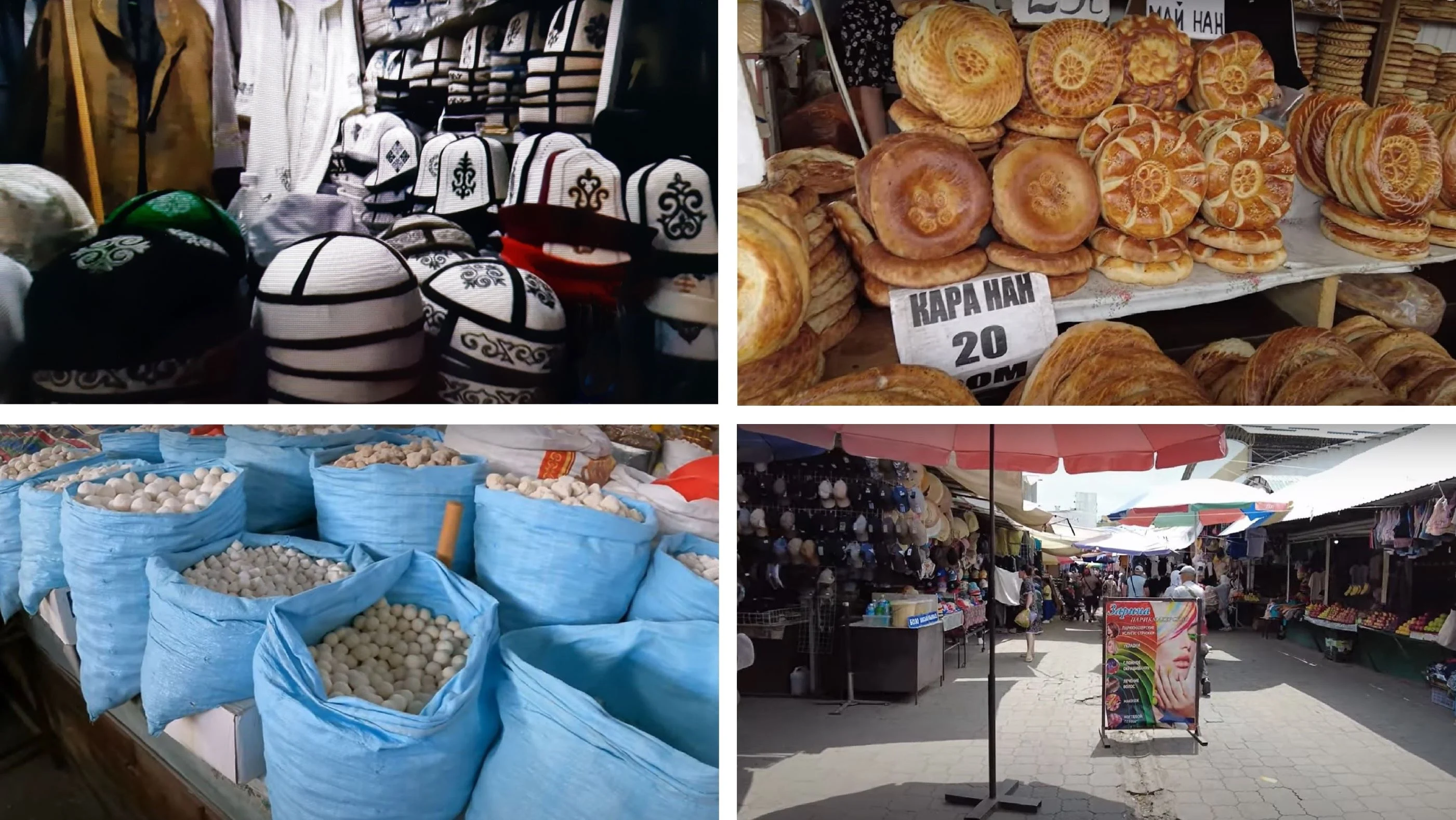We are travelling the Silk Road in Central Asia and recently enjoyed being in Tajikistan’s capital, Dushanbe. From there we flew into Kyrgyzstan, a country of around 7 million mostly Islamic people under age 30, that has seen many civilizations travelling through it on the Silk Road. It is a mountainous country lying within the Tian Shan and Pamir mountain ranges.
The Tian Shan range covers over 80% of Kyrgyzstan and is ever-present. You can see it from almost everywhere. It covers around 2,500 km east to west and even stretches into neighbouring China. We landed in the capital of Kyrgyzstan, Bishkek, and from our hotel window we had a glimpse of the Ala-Too Mountains, part of the Tian Shan range. After appreciating our view, we unpacked and headed out to sightsee.
We found Bishkek to be very vibrant, clean, and green. In fact, it is central Asia’s greenest city. We could see why as we walked into the city along one of its 2 km-long tree-lined walkways. These run down the centre of two double-lane main roads from the city fringe to the city centre. It was lovely to walk in the shade, and see the locals relaxing there while the traffic whizzed by beyond the tree-line.
Once in the city centre, we meandered around seeing the sights. Bishkek is a relatively low-built city with no skyscrapers, and has an interesting mix of Soviet and modern style architecture. We saw many landmark buildings such as the Opera and Ballet Theatre, the National Museum, and the ailing but interesting Circus Building, as well as several beautiful parks including one with a permanent Ferris-wheel and carnival rides.
Some of the more interesting sights were the huge Central Mosque of Bishkek which is the largest in Central Asia, the clock tower at the Bishkek Post Office, the Wedding Palace with super long stretched limos parked out the front, and Ala-Too Square with its statue of Manas the hero of the folk epic. Manas holds the Guinness Book of Records title of 'the longest epic in the world' (it’s also on the UNESCO Intangible Heritage list).
A sight that we particularly enjoyed was Victory Square. This is a place with some interesting monuments that celebrate the victory over Nazi Germany in World War II. While we were admiring this park, we saw a small contingent of the Kyrgyzstan National Guard practicing a ceremonial march. They marched in the Soviet style, even though the country declared its independence from the USSR in 1991.
Our local area on the city fringe was interesting. We walked out for dinner every evening and felt entirely safe at night as there were always dozens of people, mostly young due to the country’s young population. The local mall was huge and modern, and there were many restaurants around. We noticed that KFC is big here but McDonalds is absent.
A few days after arriving, we visited the Osh Bazaar. This is Bishkek’s main market, and it had great looking produce and a good feel overall. The clothes where interesting, and we really liked the Kalpaks, a Kyrgyz national hat for men; the beautifully decorated breads; and the kurut balls which are a hard salty cheese made from fermented milk and dried in the sun. These are a staple in a Central Asian food pantry.
a.jpg) | |
| Marg with a glass of mare's milk at our local restaurant, Bishkek, Kyrgyzstan | |
That night, we visited a local restaurant and were welcomed with a shot-glass of what looked like milk. We tasted it finding it very, very salty. When we asked what it was, we learned that it is a traditional drink of Kyrgyzstan called kymys that is made of fermented mare’s milk. The Kyrgyz are big on horse products as horses were essential for their nomadic lifestyle in the old days. Horses were used for everything including transportation, companionship, and food.
.jpg) |
| Impromptu national dance at our restaurant, Bishkek, Kyrgyzstan |
We visited the same restaurant again another evening and were rewarded with an impromptu performance of a Kyrgyz folk dance by young waiters serving in the restaurant. It was wonderful. Walking back to our hotel that night, we met a young Kyrgyz woman who spoke English. After a long conversation she asked our age, and couldn’t believe it when we told her. She said that well before women in Kyrgyzstan got to our age, they were usually old-looking, bent, and not active like us.
 |
| Night time in vibrant Bishkek, Kyrgyzstan |
After another night out, and enjoying the evening ambiance, we headed back to our hotel and prepared to move on. The next morning, the traffic noise was deafening, and cars were totally blocking the street and tooting repeatedly to express their dissatisfaction at delays. It turns out that there was a policeman on traffic duty blowing his whistle non-stop and twirling his baton constantly to manage traffic. He must go home with a very dry mouth and a sore wrist!
.jpg) |
| Mountains surrounding Bishkek, Kyrgyzstan |
We were soon leaving the mountains around Bishkek to fly to our next destination. At Bishkek airport we followed a crowd to the ground-floor security gate to get to the check-in counters. But at security, Marg had to open her suitcase and hand over her Swiss army knife. “No”, said Marg. Then red-faced, we realised that we should have first gone to the 2nd floor to check in our luggage, then come to the ground floor security with only our carry-on bags which have no knives.
-a2-for%20phone.jpg) |
| The very fertile Fergana Valley from our flight into Osh, Kyrgyzstan |
In the end, it was a short and interesting 40-minute flight over the mountains and the very fertile Fergana Valley to visit Osh, a city at the eastern end of the Fergana Valley. Osh is one of the Silk Road’s oldest cities, dating back more than 3,000 years. Initially, we weren’t sure we would get there due to border skirmishes in and around the Fergana Valley, but we managed to secure a last-minute flight.
 |
| Our guest house in Osh, Kyrgyzstan |
Walking out of the airport at Osh, we navigated through the usual melee of taxi drivers, bargaining to get a ride to our accommodation. We were staying in a guest house in Osh city. Osh is the 2nd largest city in Kyrgyzstan with a population of around 540,000 yet seems to have limited street signage, so our taxi had a few issues getting us there. We eventually found it in a lane. It was a bit tired and had supper-hard beds, but our host was absolutely delightful.
That night, we walked out locally to find dinner and found a street of very cosmopolitan restaurants and cafés. Around 90% of Kyrgyzstan’s population is Muslim and that figure is reflected in Osh's population. So, while there were some very smart restaurants, there was no alcohol. Undeterred, we opted for the local favourite of green tea.
.jpg) |
| Breakfast on the tapchan, Osh, Kyrgyzstan |
The next morning, our gracious host served us breakfast which we ate outside sitting on his tapchan, a dining table used all over Central Asia but mostly in Kyrgyzstan, and Uzbekistan. A tapchan is a large 3 m x 2 m wooden settee that has a low coffee table in the centre. The seat of the settee is covered with rugs and cushions to sit on, and the coffee table is covered with embroidered cloth. We shared it with a visiting Dutch couple and it was lovely.
When we checked out of the guest house, our host arranged to have our luggage stored at a friend’s nearby hardware shop so we didn’t have to drag it around while exploring Osh. Then he put us on a marshrutka (mini-bus) to Sulaiman-Too (Solomon’s Mountain), a pilgrimage site for Muslims and a UNESCO World Heritage Site due to its historical and cultural importance.
 |
| Sulaiman-Too (UNESCO), Osh, Kyrgyzstan |
By the time we got to the Sulaiman-Too bus stop, everyone on the marshrutka was signalling us to get off and loudly telling the driver to stop. A woman with an amazing set of gold teeth gestured to us to follow her and her daughter, and they showed us the rest of the way to the mountain. Lovely people. But to get up to the pilgrimage site, required climbing about 200 metres up the mountain via very, very many rough concrete steps.
The view of Osh city from the steps was wonderful. We climbed in fits and starts and Marg went on and conquered the mountain. But it was too much for Leigh in the 30+ degree heat. She found shade and a breeze, and chatted to people as they passed by on their pilgrimage. Eventually, we descended, and totally tired out, sat in the nearby gardens to eat our lunch (we had sore calf muscles for days after).
 |
Bazaar in Osh, Kyrgyzstan |
After lunch, we grabbed a taxi and visited the bazaar, which is huge. While there, we stopped at a dried fruit stall to top up our supplies, and found that the vendor spoke English. He had been working in Europe but was now home because his parents want him to get married and are now looking for a bride for him. After that, we caught a taxi back to a café near the hardware shop, and relaxed in the aircon for a few hours.
Soon it was time to collect our luggage before our flight out of Osh. We’d been told to leave it in the middle of the hardware shop as nobody would touch it. We did that, trusting it would be ok, and it was. The guys in the shop were so sweet. They called a taxi for us and saw us safely on our way. As we drove off, we were warmed by the friendliness of the people we’d met in Bishkek and Osh. Our next blog will be about more historic places in Kyrgyzstan.
This blog is one in a series about our travels along the Silk Road of Central Asia.



-a.jpg)

-a.jpg)


a2-for%20phone.jpg)
%20views%20from%20(1)-Lan2.jpg)
